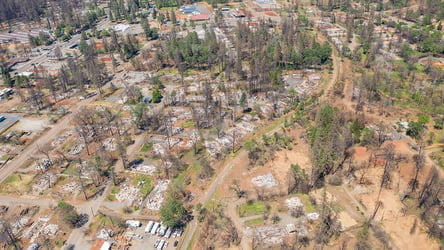Water damage is one of the top drivers of property loss across commercial and residential real estate. Whether triggered by a major weather event or a plumbing failure, the effects can be disruptive and costly. Repairs, business interruption, tenant displacement, and mold remediation often follow. Your insurance only works if you cover the right risks, report damage quickly, and document thoroughly.
These losses are on the rise. As severe weather events increase and internal system failures grow more frequent, so do financial exposures. Construction shortcuts and aging infrastructure only compound the risk. With so much at stake, prioritizing prevention and response plans helps protect your property and bottom line.
Recognize where water damage happens — and why it’s increasing
Moisture can originate from outside or within. Weather-related causes include hurricanes, heavy rainfall, flash flooding, snowmelt, and ice dams. These events are becoming more intense and frequent.
Internal causes are more common and often more damaging. A burst pipe in an upper floor can ruin multiple units' walls, ceilings, flooring, and furniture. Leaky HVAC systems, corroded pipes, broken sump pumps, faulty water heaters, and poorly sealed windows can all lead to significant loss.
These incidents aren’t isolated. In 2024, the U.S. experienced 27 billion-dollar weather events, 25 involving water. Meanwhile, there’s been a surge in internal water damage claims, often caused by outdated systems or human error. Common oversights include missing insulation, improperly installed appliances, or failing to shut off water valves before long weekends.
The impact includes disruption to tenants and business operations, costly remediation, and insurance challenges (which often carry over into the claims process). Understanding how your insurance coverage works can help avoid costly surprises.
Water-related insurance considerations
While water damage often leads to six-figure losses, many claims don’t exceed the deductible. With property deductibles usually set at $100,000, businesses frequently absorb the cost.
That’s not the only concern. Several common issues can hinder recovery:
- Delayed reporting may jeopardize coverage
- Policies often exclude coverage for long-term seepage
- Mold sublimits frequently fall short of covering full remediation costs
- Flood exclusions may limit payout during weather events
As the frequency and severity of losses increase, some carriers are applying stricter underwriting terms. That could mean higher premiums, reduced capacity, or tightened exclusions in future renewals.
Organizations that experience repeat water claims may also face tougher renewal negotiations or higher retentions. Fortunately, many losses are preventable.
Mitigate water risks with a strong plan
Proactive planning is the best way to minimize losses and protect insurability. Have a comprehensive water mitigation strategy in place for every property:
- A valve shut-off map for all water sources
- Emergency vendor contact lists for remediation and plumbing
- Clear 24/7 response protocols for staff and tenants
- Inspection schedules for key systems (HVAC, plumbing, sump pumps)
Consider these steps to reduce the risk of damage:
- Install leak detection devices in high-risk areas (kitchens, basements, mechanical rooms)
- Use automatic water shut-off valves with real-time alerts
- Insulate exposed pipes and poorly heated areas, especially attics, stairwells, and entranceways
- Clear storm drains regularly, especially before storms and seasonal changes
- Train maintenance and operations teams to respond quickly to water leaks
Shut off the water supply to reduce risk for properties undergoing renovations or seasonal closures. If third-party vendors manage building systems, ensure their contracts include clear roles and responsibilities for emergency response.

Even with solid preparation, incidents still occur. Knowing how to respond in the moment is just as instrumental as prevention.
Act fast after a water loss
Responding quickly and documenting thoroughly are key to protecting your claim.
Take the following steps:
- Shut off the water source immediately to prevent further damage.
- Contact your insurance company immediately for instructions. (Notify all applicable insurers, including flood and wind carriers, if relevant.)
- Document the damage with photos and video before cleanup begins.
- Retain all damaged materials for the adjuster’s inspection.
- Delay permanent repairs until the carrier inspects or approves mitigation.
- Track all expenses and related documents, including:
- Emergency service invoices
- Remediation estimates
- A detailed itemized inventory of damaged property
- Leases, bylaws, and governing documents to clarify repair responsibility
Report all incidents, even if you believe the damage won’t exceed your deductible. Late or incomplete reporting can jeopardize coverage and lead insurers to deny claims.
Record every detail of the incident, including what happened, when, who responded, and what actions they took. This will help your adjuster assess the loss and ensure faster resolution.
Strengthen your facility’s resilience
Water damage is a growing threat, but it’s one you can prepare for. Strong planning, modern mitigation tools, and early reporting can reduce costs, preserve coverage, and improve outcomes.
Evaluate your current mitigation strategy:
- Do you have a water damage response plan?
- Are you using smart sensors or automatic shut-off valves?
- Do you know your deductible and coverage limits?
- Have you reviewed exclusions related to mold, flood, or seepage?
- Is your team trained to respond quickly and report immediately?
Answering ‘no’ to any one of these questions signals it’s time to act.
Water moves fast. Updating your plan now helps you stay ahead of the damage.
Want to learn more?
Connect with the Risk Strategies Real Estate team at realestate@risk-strategies.com.
About the authors
For over 30 years, Ken Cullen has worked with corporations worldwide on property loss prevention for multiple industries: textile and paper mills, automotive, food processing, public utilities, and more. With Risk Strategies, he assists clients in identifying property-related risks and ways to mitigate them, including water damage prevention strategies.
Mike Bostley handles large and complex property claims nationally and regularly sees preventable water-related losses. He and his team coordinate and oversee complicated claims involving multiple carriers, insurance policies, and claim adjusters.
This article recaps our recent webinar: Water Damage Mitigation and Claims






